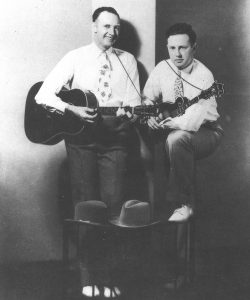 Armadillo World Headquarters, CBGB’s, The Bluebird Café, Tipitina’s, Whisky A Go-Go, the Village Gate, all names of landmark live music venues. These spaces are inseparable from the music scenes fermented inside their walls, and the proper names themselves have come to represent far more than the physical structures. The words conjure structures of feeling of specific eras (whether the business is still open or not), reflecting cultural and musical histories that reach far beyond the individuals who actually experienced these spaces, becoming almost mythological in their stature. The lists of musicians who played on the stages, the performances and collaborations that seem out of fanboy dreams, and the glimpses into these worlds through scattered photographs, films, and audio recordings only add to the ethereal nature of their reputations. The reality of struggling small businesses operating on the fringes of society and exhausted musicians toiling to keep their heads above water get lost in the narrative, but the influence of these venues depends more on the dream than the reality.
Armadillo World Headquarters, CBGB’s, The Bluebird Café, Tipitina’s, Whisky A Go-Go, the Village Gate, all names of landmark live music venues. These spaces are inseparable from the music scenes fermented inside their walls, and the proper names themselves have come to represent far more than the physical structures. The words conjure structures of feeling of specific eras (whether the business is still open or not), reflecting cultural and musical histories that reach far beyond the individuals who actually experienced these spaces, becoming almost mythological in their stature. The lists of musicians who played on the stages, the performances and collaborations that seem out of fanboy dreams, and the glimpses into these worlds through scattered photographs, films, and audio recordings only add to the ethereal nature of their reputations. The reality of struggling small businesses operating on the fringes of society and exhausted musicians toiling to keep their heads above water get lost in the narrative, but the influence of these venues depends more on the dream than the reality.
The Eugene Earle Collection is full of recorded artifacts that help fill out the narratives, exposing more of the reality but adding to the dream at the same time. The country music parks like New River Ranch (featured here a week ago) offered one kind of performance opportunity for the traditional country and mountain music in the 1950s and 1960s, but the folk clubs, coffeehouses and college stages offered another. The Ash Grove is one of the latter.
Founded in Hollywood by Ed Pearl in 1958, the Ash Grove was unprecedented in the variety of folk legends and young artists that shared the stage. The club offered many musicians from the South and East their first opportunities to find audiences on the West Coast. Doc Watson, The Country Gentlemen, Mississippi John Hurt, Son House, Muddy Waters, Pete Seeger, June Carter, Johnny Cash, Phil Ochs, Joan Baez, Johnny Otis, Ramblin’ Jack Elliott, Ian and Sylvia, Sonny Terry, Brownie McGee, New Lost City Ramblers, The Weavers, The Greenbriar Boys, Lightnin’ Hopkins, Barbara Dane, Holly Near, Arlo Guthrie, Mance Lipscomb, Guy and Candie Carawan, John Jacob Niles, Bukka White, and Kris Kristofferson all played the Ash Grove. As did Oscar Brown, Jr., Chuck Berry, James Booker, Ravi Shankar, Mongo Santamaria, Miriam Makeba , and the Virgin Islands Steel Band. Ry Cooder had his first performance there when he was 16 and the Stanley Brothers, featured in the clips below, performed there numerous times throughout the 1960s. The Ash Grove closed in 1973, possibly as a result of arson attacks by those who disagreed with the venues left leaning social and political affiliations, but it’s legacy lives on in the collective cultural memory, thankfully bolstered by recordings like those in the Eugene Earl Collection here at the SFC.
Digitized for the project Fiddles, Banjos, and Mountain Music: Preserving Audio Collections of Southern Traditional Music, the following clips come from FT-12936 of the Eugene Earl Collection. The Stanley Brothers in this incarnation include Carter Stanley on guitar, Ralph Stanley on banjo, Vernon Derek on fiddle, Curly Lambert on mandolin, Roger Bush on bass. Recorded August 30, 1962, the performance includes a variety of traditional mountain music, bluegrass standards, and Stanley Brothers originals.
More recordings from the Ash Grove to come, but for now enjoy the Ash Grove intro with the Stanley Brothers kicking off the show with “Late Last Night”: late last night_stanley bros
and Carter’s introduction of “Drifting too Far From the Shore” with a description of the “Monroe Sound” and a touching acknowledgement of Charlie Monroe’s contribution to country music: Drifting too far_Stanley Brothers_mo
The ongoing digitization project Fiddles, Banjos and Mountain Music: Preserving Audio Collections of Southern Traditional Music, is made possible by a grant from the National Endowment for the Humanities.
 One of the great things about archives is that you can run across interesting information in places you’d never expect. For example, the Mike Seeger tape logs in the Southern Folklife Collection Field Notes (30025) are largely comprised of long lists of the song titles and performers which make up the track listings of his numerous field recordings. But hidden among the pages and pages of track listings are occasional gems of personal musings, background stories, or random anecdotes like the following:
One of the great things about archives is that you can run across interesting information in places you’d never expect. For example, the Mike Seeger tape logs in the Southern Folklife Collection Field Notes (30025) are largely comprised of long lists of the song titles and performers which make up the track listings of his numerous field recordings. But hidden among the pages and pages of track listings are occasional gems of personal musings, background stories, or random anecdotes like the following:

